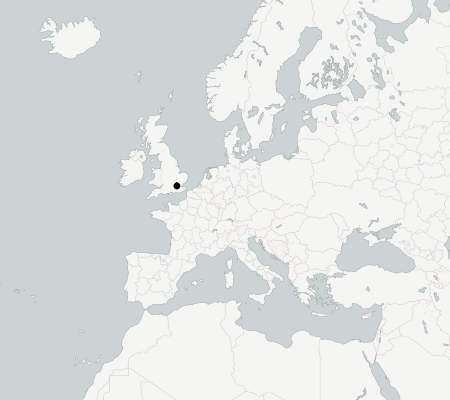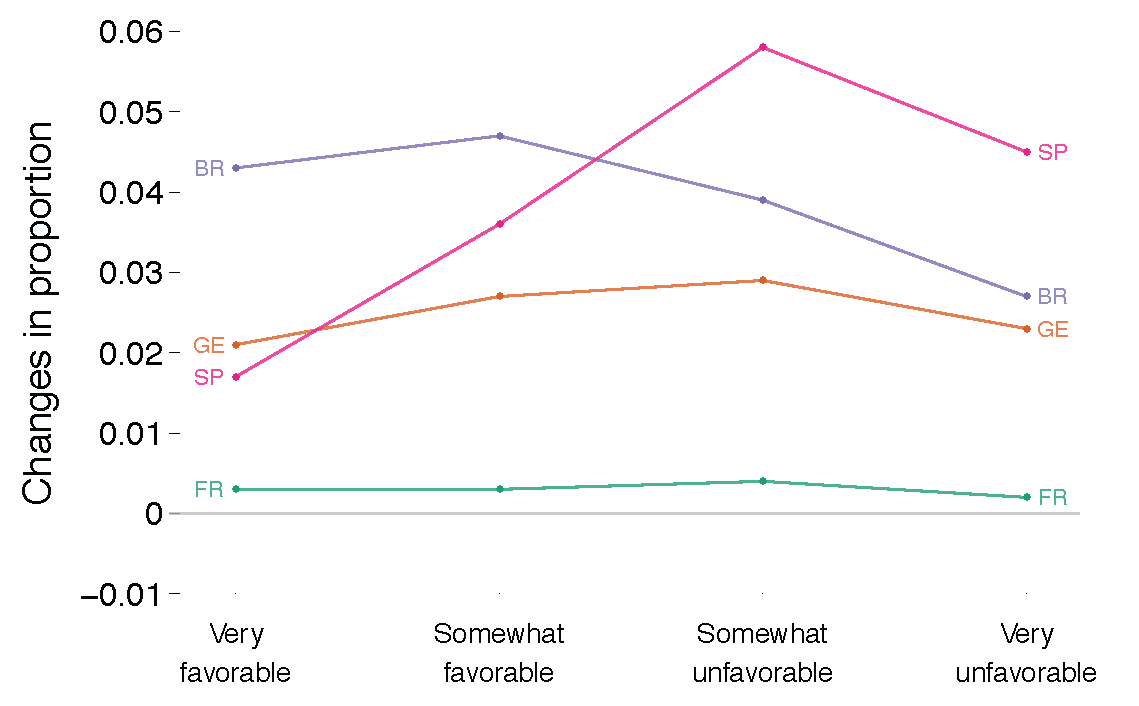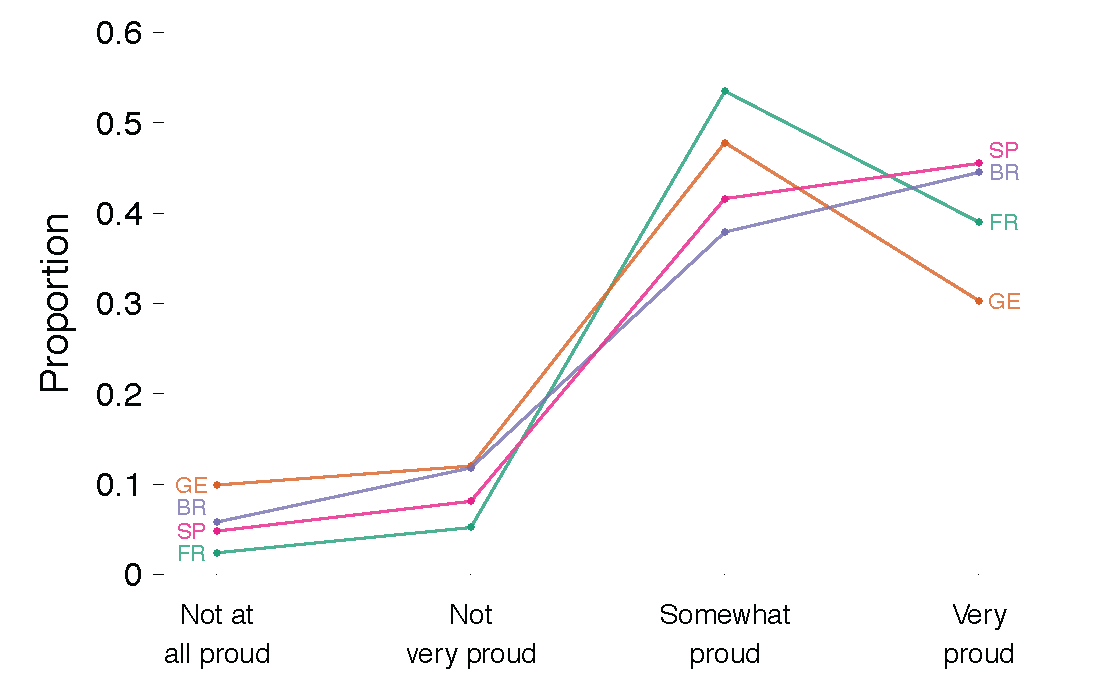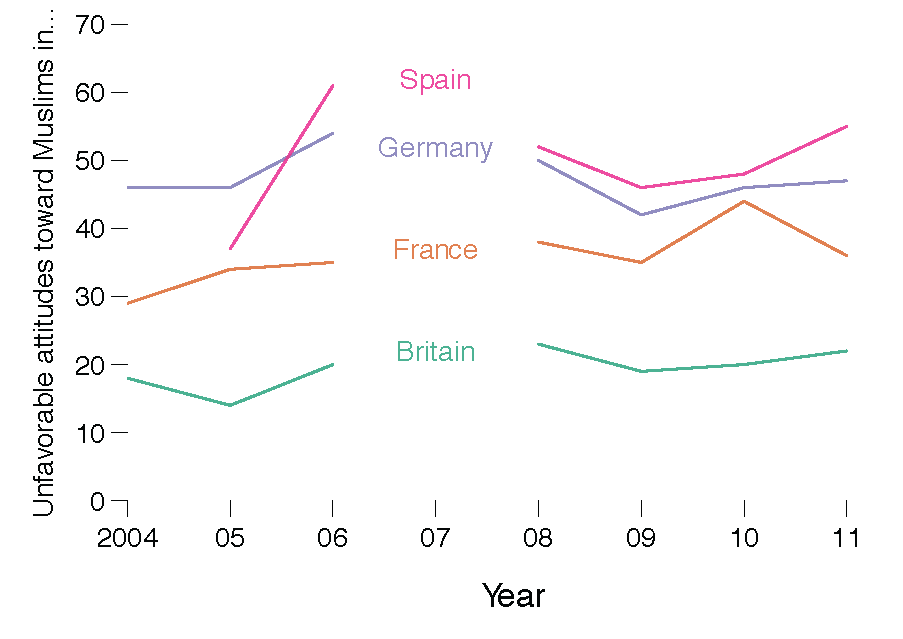Research Interests
My research explores the impacts of past cultural consolidation on contemporary political and economic performance across states. More specifically, I examine the long-run effects of premodern cultural consolidation within state on the costs of contemporary outcomes such as economic growth, public goods provision, and redistribution. In simplified form, my hypothesis is that:
High premodern cultural cohesion → low costs of state-building → high state capacity
Low premodern cohesion → high costs of state-building → low state capacity
Extant research shows that state capacity is associated with key outcomes of interest described above. Yet the origins of state capacity are yet to be systematically investigated. I argue that past cultural standardization affects modern state-building. My conceptual innovation is to offer this new framework. My empirical contribution is to test my hypothesis by constructing a series of new time-series and cross-sectional data sets. My data sets use the ethnic group as the unit of analysis and are composed of ethnic-group attributes along political, economic, social, geographical, religious, and other dimensions.
My dissertation was part of this broader agenda and sought to address why some ethnic groups standardize their culture and build institutions earlier than others. To examine this puzzle, I built new data sets on 171 European ethnic groups for the period between 1400 and 2000.
Please keep scrolling down for more detail about these projects.
Publications
"The Royal Consultants: The Intendants of France and the Bureaucratic Transition in Pre-modern Europe." Journal of Historical Political Economy 1(2) 2021. Paper (Open Access)
This article explores the intendants, the pre-modern French bureaucrats, as proto-modern bureaucrats. Historical research highlights their role in strengthening the state's fiscal capacity, but few works provide empirical evidence on the intendants as bureaucrats. My paper fills this gap by constructing a new data set of 430 intendants from 1640 to 1789, the period in which these officials were systematically assigned. I use this data set to explore personnel recruitment and appointment in comparison to venal officeholding. My findings indicate that only less than a half of the recruits went through the legally-specified training path, and a wide variability in appointment duration suggests that the state did not run it mechanically. Strong familial and marital ties in appointment also threaten impersonality. My analysis highlights the process of political development for investigation as fiscal capacity hinges on how states manage staff who administer revenue collection.
"Content with Failure? Cultural Consolidation and the Absence of Nationalist Mobilization in the Case of the Occitans in France." Social Science History 43(2), Summer 2019. Lead article. Paper + Appendix.
Does cultural consolidation among ethnic groups lead to nationalist mobilization? Extant research in the study of nationalism suggests a tight connection between the two. My paper addresses this question by operationalizing cultural consolidation through language standardization and providing an empirical analysis. I argue that not all ethnic groups that consolidate their culture build institutions toward sovereignty and propose that cases that fail to invest in institutions make strong contributions to the existing framework in the literature. Following a brief survey on the Bulgarians as a case of successful mobilization, I document evidence from an in-depth study on the Occitans, a minority ethnic group in France, as a failed case. Findings from a process-tracing approach indicate that although the Occitans standardized their language by 1900, leading intellectuals became content with the situation and failed to make the next move. I contribute by operationalizing cultural consolidation and by introducing "institution-building" as a crucial outcome between cultural consolidation and state-building. My paper suggests that decisions of ethnic elites matter to understand why some groups start nationalist mobilization.
"Publishing Nations: Technology Acquisition and Language Standardization for European Ethnic Groups." Journal of Economic History 77(4) December 2017. Paper + Appendix.
Best Doctoral Students Paper Award, Nationalism Section, Association for the Study of Nationalities (ASN), 2017.
Best Graduate Paper Award, Department of Political Science, University of Washington, 2015.
This article examines the causes and variation of language standardization across European ethnic groups from a historical perspective. Although language has long garnered interest in the study of ethnicity and nationalism, how language becomes standardized has yet to be offered. In this paper, I make and empirically examine two hypotheses. First, I argue that the acquisition of the press is critical, because it reduces the cost of access to information and of becoming literate. Second, I hypothesize that the early adoption of printing technology leads to early language standardization, because codification is a highly time-consuming process. Using the first publication of vernacular dictionaries as a proxy for standardization, I present a systematic investigation of the standardization process for 171 ethnic groups in Europe from 1400–2000 C.E. Findings from the Cox proportional hazards model show that (1) the adoption of print technology increases the chances of vernacular codification by 4-9 times; and (2) early adopters of the press (press by 1500) have 6 percentage points greater chances for language standardization than latecomers (press by 1800). These findings are robust to inclusion of a host of covariates, alternative mechanisms that include the human capital channel, and other models including logistic regression and an instrumental-variable (IV) approach, where I exploit the exogenous variation of the distance to Mainz as an IV for the homeland cities of European ethnic groups.
I show summary statistics below. First, I display the spread of printing technology across Europe for 1500-1800 at the 100-year interval. I show Mainz, Germany, where the Gutenberg press was invented in the red dot. Black dots denote the print adoption for an ethnic group in the given period. Circles indicate the distance from Mainz in the 500km, 1,000km, and 2,000km radius. These figures suggest that print technology spread in a concentric circles fashion, in consistent with the literature.
Second, I display the spread of vernacular dictionaries, as a proxy for language standardization, for 1800-2000 at the 50-year interval. Black dots denote the publication of vernacular dictionaries for an ethnic group in the given interval.
Third, I display the time-series adoption of the printing press and vernacular dictionaries. The left panel shows the acquisition of the printing press between 1450 and 2000 (n=96/171 ethnic groups). It indicates that about half of those adopted a press did so during the incunabula period (i.e., the first fifty years of the Gutenberg invention). The right panel shows similar data for the vernacular dictionary for 1750-2000. It indicates that more than half of all those written vernacular dictionaries took place after 1950. It takes, on average, 360 years between print and dictionary (the median is 390 years). This gives descriptive evidence for the slow evolution of language standardization after the adoption of the key technology.
Working papers
"Postal Growth: How the State-Sponsored Post Affected Growth in France, 1550-1800." (September 2021, under review; formerly titled "Ethnic Autonomy" APSA Preprint v3)
This article investigates the expansion of postal networks in early-modern Europe and its implications for pre-modern growth. Existing research indicates that early-modern states had limited technologies of control to identify subjects and raise revenue effectively. I describe how they exploited an improved and faster postal system for policymaking yet made little strategic investment. I document its consequences to city-level growth by constructing a new panel data set on early-modern France. Digitizing hitherto untapped published sources, I quantify changes in travel costs from Paris based on postal routes from 1550–1800 and explore how postal assignment affected city growth. My analysis finds that reductions in travel cost are positively associated with growth. I also show that benefits are largely confined to on-route cities and that evidence of positive externalities is not strong. My findings suggest how the state may have picked the economic “winners" through postal assignment in the period.
"Language Underpinnings on Europe's Rise" (March 2019)
Cultural factors play an increasingly important role in understanding long-run economic growth. While the literature pays closer attention to the standardization of knowledge and technical skills, that of language, a medium that underpins innovations, trade, and production, has not been widely explored. In this paper, I investigate the sources of language rationalization in European history, by focusing on the development of the grammar---a milestone for other rules of language use. I describe three channels from the early-modern period that explain the timing of rationalization: political fragmentation, Protestant Reformation, and humanism. I test my hypotheses by using a data set of 25 European states from 1300--1800. Evidence from my statistical analysis shows that grammar publication is positively and significantly linked to premodern growth and is robust to inclusion of major determinants of growth, such as Atlantic trade and executive constraints. It also suggests that my measures on political fragmentation, Reformation, and humanism weakly inform the variation in the timing of grammar publication.
"Continuity or Contingency? The Patterns of National-Identity Salience on Europeans' Attitudes toward Muslims" (May 2016)
Do European populations invoke national identities in their opinions about immigrants? How do they differ across countries, and why? This paper provides two theoretical frameworks and statistical evidence to understand the sources of national-identity salience in Europeans' attitudes toward Muslims. I draw hypotheses from two related fields: (1) the continuity channel in nationalism studies, in which the identity salience comes from the institution-building on nationality as a long-term consequence of state formation, and (2) the contingency path in immigration studies, where more recent changes in the economy have a greater impact. I draw evidence from the 2008 Pew data that contains unique information about Europeans' opinions about specific groups and use multiple imputation to exploit the complete data. Evidence from probit and ordered probit models suggests that although the historical legacy of nationality institutions matters, the perception of country-level economic performance moderates it and has consistent effects on Europeans' views of Muslims. This paper contributes to the contemporary immigration debate in advanced democracies by bridging between the study of nationalism and the immigration literature. Specifically, evidence implies that immigrants are likely to be accepted so long as the economy is performing well at the country level.
I discuss summary statistics below. In this paper, I use survey and descriptive data sets collected by the Pew Research Center. The main data set I use for statistical analysis is “Unfavorable Views of Jews and Muslims on the Increase in Europe,” Pew Global Attitude Project, 2008. This data set is unique in that it asks survey respondents' opinions about specific groups like Muslims, Christians, and Jews.
The outcome variable is Europeans' unfavorable attitudes toward Muslims. Discussing one's opinion about ethnicity and race in a public survey can be perceived as sensitive and can lead to social desirability bias. Survey respondents may dodge questions involving ethnicity and race by answering "I don't know" or "I refuse to answer." To mitigate this problem, I turn to multiple imputation methods before conducting regression analysis. The figure below shows the distribution of Europeans' attitudes toward Muslims from imputed data. Although the magnitude of the changes in proportion is small across all response categories, imputation provides improvement in data. Key: SP=Spain, GE=Germany, FR=France, BR=Britain.
Second, I show the distribution of a main explanatory variable, Europeans' national identity. The data is also from the imputed data. Key: SP=Spain, GE=Germany, FR=France, BR=Britain.
Third, I discuss descriptive evidence. The left figure below shows the percentage of Muslim populations across fifteen European countries. The population data draws from “The Future of the Global Muslim Population,” Pew-Templeton Global Religious Futures Project 2011.
If population size is the sole driver of individuals' attitudes toward Muslims, societies with higher percentage should exhibit greater unfavorable attitudes. The time-series figure on the right rejects this simple hypothesis, where Spain ranks the highest on unfavorable opinions, although Muslims in Spain constitute 2.3 percent of the population. This data comes from “Muslim-Western Tensions Persist,” Pew Global Attitudes Project, 2011. Note that the data for 2007 is missing.
Book Reviews
Review of Dancygier, Rafaela M. 2010. Immigration and Conflict in Europe.
Comparative Political Studies, 2012, (45)2: 267–271.Review of Lange, Matthew. 2012. Educations in Ethnic Violence.
Comparative Political Studies, 2012, (45)11: 1435–1439.Review of Dudley, Leonard. 2017. The Singularity of Western Innovation: The Language Nexus.
EH.net, May 2018.

















